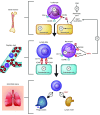Perfect timing: circadian rhythms, sleep, and immunity - an NIH workshop summary
- PMID: 31941836
- PMCID: PMC7030790
- DOI: 10.1172/jci.insight.131487
Perfect timing: circadian rhythms, sleep, and immunity - an NIH workshop summary
Abstract
Recent discoveries demonstrate a critical role for circadian rhythms and sleep in immune system homeostasis. Both innate and adaptive immune responses - ranging from leukocyte mobilization, trafficking, and chemotaxis to cytokine release and T cell differentiation -are mediated in a time of day-dependent manner. The National Institutes of Health (NIH) recently sponsored an interdisciplinary workshop, "Sleep Insufficiency, Circadian Misalignment, and the Immune Response," to highlight new research linking sleep and circadian biology to immune function and to identify areas of high translational potential. This Review summarizes topics discussed and highlights immediate opportunities for delineating clinically relevant connections among biological rhythms, sleep, and immune regulation.
Conflict of interest statement
Figures



References
Publication types
MeSH terms
Grants and funding
LinkOut - more resources
Full Text Sources
